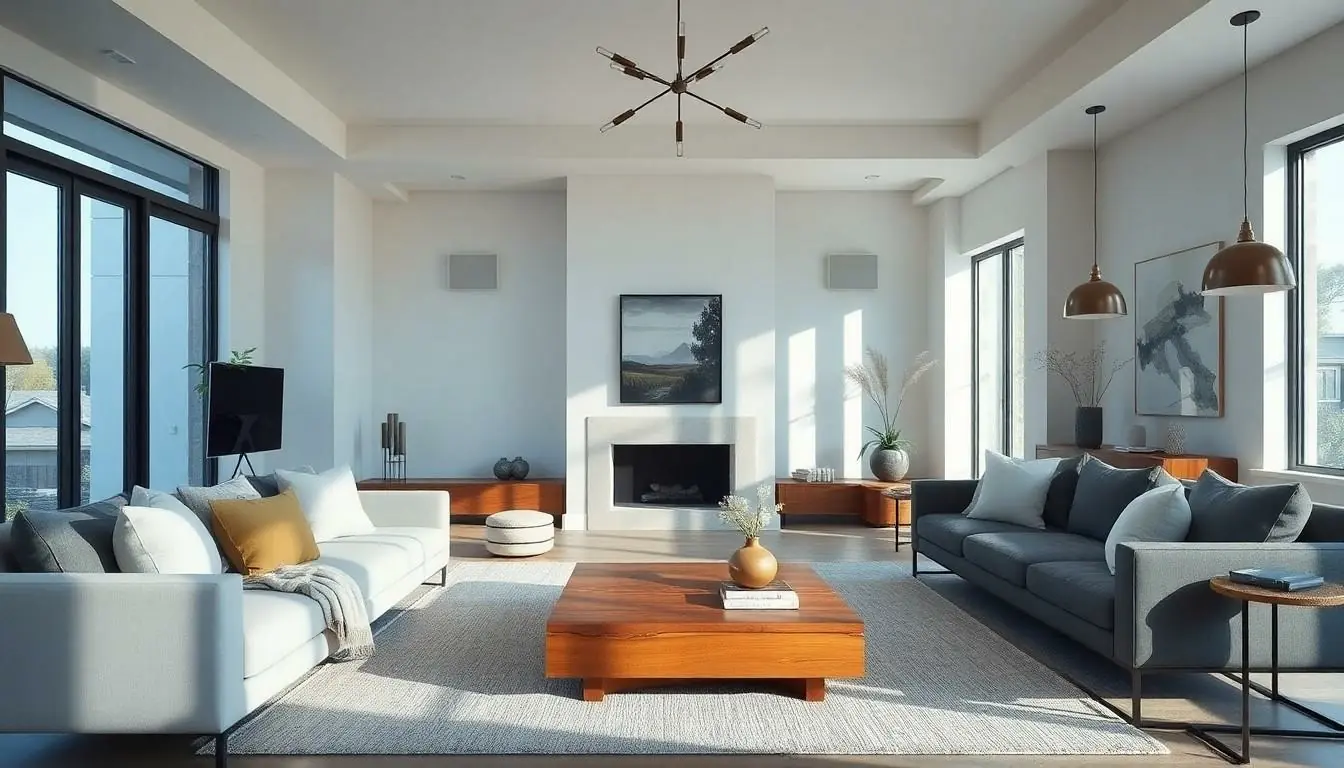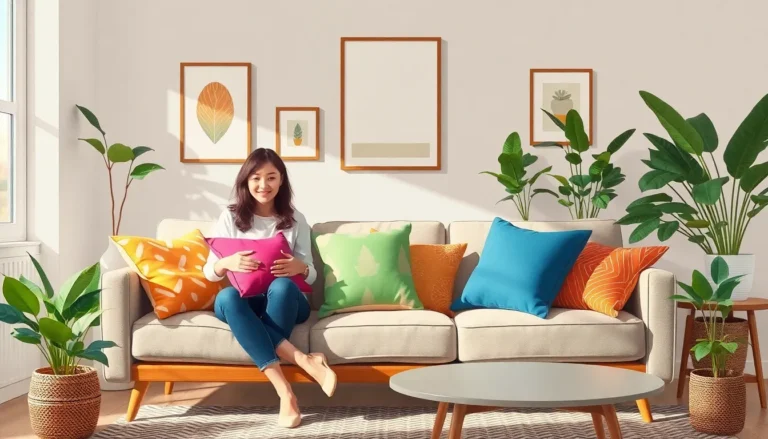Table of Contents
ToggleTransitional architecture is like the stylish chameleon of the design world, effortlessly blending the old with the new. Imagine walking into a space that feels both cozy and contemporary, where traditional charm meets modern flair. It’s the architectural equivalent of a perfectly brewed cup of coffee—comforting yet invigorating.
As homeowners increasingly seek to create inviting environments, transitional architecture steps in to save the day. It takes the best elements of classic design and marries them with sleek, modern aesthetics. This approach not only enhances visual appeal but also makes spaces more functional and livable. So, if you’re ready to transform your home into a harmonious haven, it’s time to explore the delightful world of transitional architecture. Who knew design could be this much fun?
Understanding Transitional Architecture
Transitional architecture merges traditional charm with modern functionality. This design style emphasizes balance, creating warm and inviting spaces.
Definition and Key Concepts
Transitional architecture refers to a design approach that combines elements from traditional and contemporary styles. This fusion results in spaces that feel harmonious and cohesive. Key concepts include simplicity, neutral color palettes, and timeless furnishings. Clean lines characterize transitional design, which enhances the overall aesthetic without overwhelming the senses. Furniture often features soft textures while maintaining classic shapes, offering both comfort and style. The aim centers on creating environments that suit everyday living while still looking sophisticated.
Historical Context
Transitional architecture emerged in the late 20th century as a response to rapidly changing design trends. Homeowners began seeking styles that blended the best of both worlds, addressing the desire for comfort alongside modern elegance. Influences from various periods contributed to its development, integrating elements from colonial and mid-century modern designs. This evolution resulted in architecture reflecting cultural shifts and evolving lifestyles. As preferences shifted, transitional design gained traction, illustrating the adaptability of residential spaces to meet diverse needs.
Characteristics of Transitional Architecture

Transitional architecture combines traditional and modern design elements, creating inviting and balanced spaces. This style prioritizes functionality while maintaining a sophisticated aesthetic.
Design Elements
Clean lines define the design aspects of transitional architecture. Neutral color palettes contribute to a calming environment, allowing for easy integration of decorative elements. A mix of modern and classic furnishings can often be found, blending soft textures with timeless shapes. Statement pieces enhance the visual interest without overwhelming the overall look. Many spaces incorporate open layouts, fostering a sense of flow and connection between areas. Lighting choices, from understated fixtures to bold statement pieces, play a crucial role in accentuating the style’s elegance.
Material Usage
Various materials characterize transitional architecture. Wood, glass, and metal often come together in harmonious combinations. Warm woods add a touch of warmth and comfort, while sleek metal finishes provide a modern twist. Textiles frequently include soft fabrics like linen and cotton, enhancing the cozy atmosphere. The use of natural materials creates a connection to the environment, promoting sustainability. Accents made of stone or brick might also feature, grounding spaces with their enduring qualities. Overall, the thoughtful selection of materials reinforces the design’s adaptability and timeless appeal.
Examples of Transitional Architecture
Transitional architecture showcases innovative applications around the world. Several notable projects illustrate this unique design style.
Notable Projects
The Kleinburg Residence in Ontario exemplifies transitional architecture with its blend of classic brick and modern glass. This home features open spaces that facilitate natural light and fluid movement. Another example is the Mackie House in California, which harmonizes traditional wood elements with contemporary finishes. This project highlights the successful integration of outdoor and indoor spaces. Additionally, the Berkshire House in Massachusetts showcases sleek lines and a neutral color palette, creating a serene atmosphere that emphasizes comfort and functionality.
Influential Architects
Prominent architects drive the evolution of transitional architecture. Robert A.M. Stern uses balanced proportions and timeless details in his designs, making classics feel modern. Katherine Lo integrates sustainable materials while maintaining a sophisticated aesthetic. Another key figure is Thomas O’Brien, known for his ability to blend modernism with historical influences in his residential projects. Each of these architects contributes to a richer understanding of transitional design while pushing boundaries that enhance livability.
Benefits of Transitional Architecture
Transitional architecture offers numerous benefits that enhance both the visual and practical aspects of living spaces.
Aesthetic Appeal
Visual harmony defines transitional architecture. The blend of modern and traditional elements creates inviting environments that are visually appealing. Neutral color palettes dominate, facilitating effortless integration with existing decor. Clean lines establish a sense of order, contributing to a serene ambiance. Soft textures and classic furnishings enhance comfort while maintaining style. This approach allows homeowners to express personal tastes while keeping a sophisticated elegance. Notable designs, such as those found in the Kleinburg Residence, showcase how transitional architecture achieves a beautiful balance.
Functional Versatility
Functional versatility serves as another cornerstone of transitional architecture. Open layouts maximize space, promoting interaction and flow among family members. This adaptability accommodates various lifestyles, making it suitable for both casual gatherings and formal events. Thoughtful design ensures that furnishings and decor support daily activities while reinforcing aesthetic appeal. A mix of materials enhances both warmth and modernity, with wood and metal complementing one another seamlessly. By integrating sustainable practices, such as using natural textiles, transitional architecture addresses contemporary living needs without sacrificing style.
Challenges in Transitional Architecture
Transitional architecture faces several challenges that require careful consideration and planning.
Design Limitations
Design limitations often arise when blending different styles. Balancing traditional and modern elements can lead to conflicts in aesthetics. Achieving cohesion in the design may become difficult without careful integration of materials and color schemes. Moreover, architectural regulations in some areas impose restrictions that might hinder the desired design. Specific choices in furnishings and decor may not seamlessly fit the transitional style, impacting the intended visual effect. When conceptualizing spaces, finding the right balance between comfort and style can test even seasoned architects.
Environmental Considerations
Environmental considerations play a significant role in transitional architecture. Maximizing energy efficiency remains essential; using sustainable materials can be challenging within this design framework. Homeowners frequently prefer diverse textiles and wood, which may not always align with eco-friendly practices. Furthermore, minimizing environmental impact often requires innovative approaches to design. Architects must navigate compliance with local building codes that promote sustainability while adhering to the transitional aesthetic. Integrating green technologies can enhance functionality but may also complicate achieving visual harmony in the overall design.
Transitional architecture stands as a testament to the beauty of blending styles. It creates spaces that are not only visually appealing but also functional and inviting. This design approach resonates with homeowners seeking to balance tradition and modernity in their living environments.
By emphasizing clean lines and neutral palettes, transitional architecture fosters a calming ambiance. Its versatility meets the diverse needs of contemporary lifestyles while promoting sustainability through thoughtful material choices. As this style continues to evolve, it remains a popular choice for those aiming to enhance their homes with sophistication and timeless appeal. Exploring transitional architecture can lead to discovering unique design possibilities that elevate everyday living.







